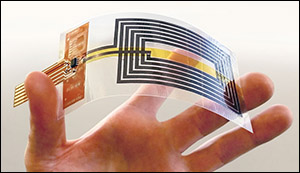Graphene Enables Fully Flexible NFC Antennas
5. 12. 2016 | Graphene Flagship | graphene-flagship.eu
Graphene is currently one of the most extensively studied materials in the world, both on scientific and industrial level. The world’s first two-dimensional material, this single layer of carbon atoms arranged in a hexagonal lattice has a series of unique and outstanding properties.
As well as being the thinnest, strongest and lightest known material, graphene is flexible, impermeable and extremely electrically and thermally conductive. All properties well suited for next generation NFC antennas.

Near-field communication (NFC) is a set of communication protocols that enables two electronic devices to transfer data. The most distinctive characteristic of NFC is the fact that it can transmit small amount of data wireless only within a close range while other methods, such as Bluetooth and Wi-Fi, have a wide transmit range of up to 10 or even 100m. The reason why NFC technology is used to identify objects is that, with such a close transmitting range, it is more secure and less vulnerable to data hijacking.
By combining material characterization, computer modelling and engineering of the device, the Graphene Flagship researchers designed an antenna that could exchange information with near-field communication devices such as a mobile phone, matching the performance of conventional metallic antennas. The graphene-based NFC antennas are chemically inert, highly resistant to thousands of bending cycles and can be deposited on different standard polymeric substrates or silk tissues.
Read more at Graphene Flagship
Image Credit: Graphene Flagship
-jk-




